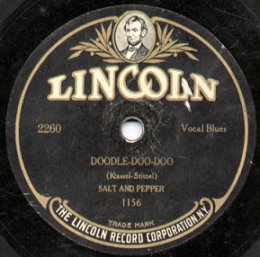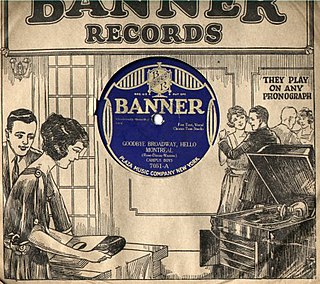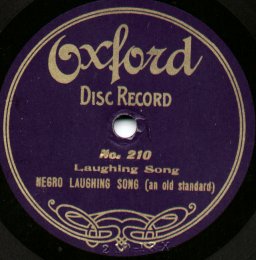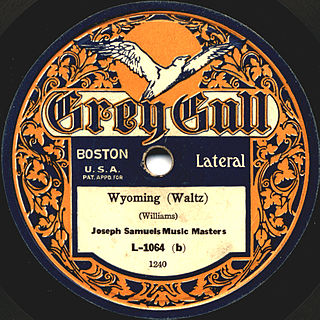This article needs additional citations for verification .(April 2018) (Learn how and when to remove this template message) |
| Oriole Records | |
|---|---|
Oriole disc sleeve | |
| Founded | 1921 |
| Founder | McCrory's |
| Defunct | 1937 |
| Status | Defunct |
| Country of origin | U.S |
Oriole Records was an American record label founded in 1921 by McCrory's stores. [1]
A record label, or record company, is a brand or trademark associated with the marketing of music recordings and music videos. Sometimes, a record label is also a publishing company that manages such brands and trademarks, coordinates the production, manufacture, distribution, marketing, promotion, and enforcement of copyright for sound recordings and music videos, while also conducting talent scouting and development of new artists, and maintaining contracts with recording artists and their managers. The term "record label" derives from the circular label in the center of a vinyl record which prominently displays the manufacturer's name, along with other information. Within the mainstream music industry, recording artists have traditionally been reliant upon record labels to broaden their consumer base, market their albums, and be both promoted and heard on music streaming services, radio, and television. Record labels also provide publicists, who assist performers in gaining positive media coverage, and arrange for their merchandise to be available via stores and other media outlets.
Contents
The Oriole label first appeared in 1921, selling for 25 cents per disc record. Originally, Oriole records were pressed by the Cameo Record Company (generally not from Cameo material, however), but this arrangement lasted briefly. Most of the masters were leased from other labels, early on mostly Emerson. From around number 115, Orioles were pressed by Grey Gull and usually have unusual pairings of material, with one side being a hit popular tune and the other "standard" material, sometimes classical music. At number 250, Orioles began being pressed by the Plaza Music Company, which also pressed Banner Records, and whose issues were the original labels to be treated as "cheap" labels. Oriole and Banner, in common with Jewel Records, the Sears & Roebuck label Challenge Records, and a few others, often used a standard set of "noms du disque" on their labels, rather than the actual names of the artists who recorded the tracks they issued. Plaza-pressed Orioles used "control numbers" to disguise their matrix numbers; oddly enough, these were later to appear on the flagship Banner label. After Plaza was merged into the American Record Corporation, ARC matrix numbers replaced the control numbers.

The United States dollar is the official currency of the United States and its territories per the United States Constitution since 1792. In practice, the dollar is divided into 100 smaller cent (¢) units, but is occasionally divided into 1000 mills (₥) for accounting. The circulating paper money consists of Federal Reserve Notes that are denominated in United States dollars.

Cameo Records was an American record label that flourished in the 1920s. It was owned by the Cameo Record Corporation in New York City.
During the 1930–32 period, ARC dropped a number of their labels; however, Oriole continued (due to the successful McCrory's contract), using the same number series (which eventually reached past 2000) as well as another series for country and race records. In August, 1935, all the low-priced labels owned by ARC began using a new, date-related numbering system, in which the last digit (originally the last two digits) of the year was followed by the number for the month and finally a two-digit serial number specific to that month's releases. Race and country music records started their serial numbering at 51, so a blues record released in February, 1936 would carry a number like 6-02-51.

Race records were 78-rpm phonograph records marketed to African Americans between the 1920s and 1940s. They primarily contained race music, comprising various African-American musical genres, including blues, jazz, and gospel music, and also comedy. These records were, at the time, the majority of commercial recordings of African-American artists in the US. Few African-American artists were marketed to white audiences. Race records were marketed by Okeh Records, Emerson Records, Vocalion Records, Victor Talking Machine Company, Paramount Records, and several other companies.
Country music, also known as country and western, and hillbilly music, is a genre of popular music that originated in the southern United States in the early 1920s. It takes its roots from genres such as folk music and blues.
Blues is a music genre and musical form which was originated in the Deep South of the United States around the 1870s by African Americans from roots in African musical traditions, African-American work songs, spirituals, and the folk music of white Americans of European heritage. Blues incorporated spirituals, work songs, field hollers, shouts, chants, and rhymed simple narrative ballads. The blues form, ubiquitous in jazz, rhythm and blues and rock and roll, is characterized by the call-and-response pattern, the blues scale and specific chord progressions, of which the twelve-bar blues is the most common. Blue notes, usually thirds, fifths or sevenths flattened in pitch, are also an essential part of the sound. Blues shuffles or walking bass reinforce the trance-like rhythm and form a repetitive effect known as the groove.
As the Depression and the popularity of radio cut into record sales, most of the store labels were discontinued; another factor was that the younger record buyers looked for specific versions of their favorite tunes, so name artists like Glenn Miller and Benny Goodman made up the majority of discs sold. The last Oriole records seem to have been issued in January, 1937. All of the low-priced labels were dropped in April, 1938 and the American Record Corporation was acquired by the Columbia Broadcasting System later that year.

The Great Depression was a severe worldwide economic depression that took place mostly during the 1930s, beginning in the United States. The timing of the Great Depression varied across nations; in most countries it started in 1929 and lasted until the late-1930s. It was the longest, deepest, and most widespread depression of the 20th century. In the 21st century, the Great Depression is commonly used as an example of how intensely the world's economy can decline.

Radio is the technology of signalling or communicating using radio waves. Radio waves are electromagnetic waves of frequency between 30 hertz (Hz) and 300 gigahertz (GHz). They are generated by an electronic device called a transmitter connected to an antenna which radiates the waves, and received by a radio receiver connected to another antenna. Radio is very widely used in modern technology, in radio communication, radar, radio navigation, remote control, remote sensing and other applications. In radio communication, used in radio and television broadcasting, cell phones, two-way radios, wireless networking and satellite communication among numerous other uses, radio waves are used to carry information across space from a transmitter to a receiver, by modulating the radio signal in the transmitter. In radar, used to locate and track objects like aircraft, ships, spacecraft and missiles, a beam of radio waves emitted by a radar transmitter reflects off the target object, and the reflected waves reveal the object's location. In radio navigation systems such as GPS and VOR, a mobile receiver receives radio signals from navigational radio beacons whose position is known, and by precisely measuring the arrival time of the radio waves the receiver can calculate its position on Earth. In wireless remote control devices like drones, garage door openers, and keyless entry systems, radio signals transmitted from a controller device control the actions of a remote device.

Alton Glenn Miller was an American big-band trombonist, arranger, composer, and bandleader in the swing era. He was the best-selling recording artist from 1939 to 1943, leading one of the best-known big bands. Miller's recordings include "In the Mood", "Moonlight Serenade", "Pennsylvania 6-5000", "Chattanooga Choo Choo", "A String of Pearls", "At Last", "(I've Got a Gal In) Kalamazoo", "American Patrol", "Tuxedo Junction", "Elmer's Tune", and "Little Brown Jug". In just four years Glenn Miller scored 16 number-one records and 69 top ten hits—more than Elvis Presley and the Beatles did in their careers. While he was traveling to entertain U.S. troops in France during World War II, Miller's aircraft disappeared in bad weather over the English Channel.















